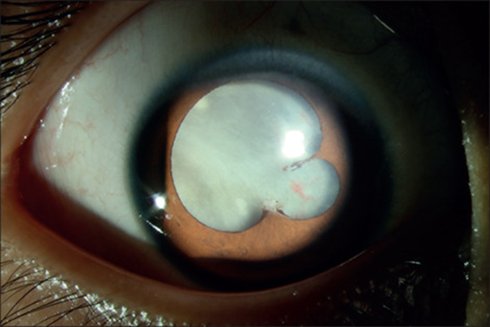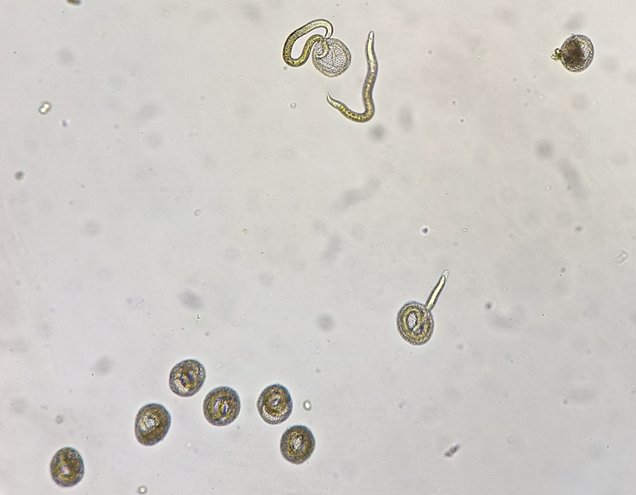Chuanguan News reporter Jiang Yunhan
Chuanguan News reporter learned from Sichuan Agricultural University on February 25 that the team of Associate Professor Xie Yue from the Animal Parasitic Disease Research Center of the School of Medicine and Professor Ding Xiaoyan from the Zhongshan Ophthalmology Center of Sun Yat-Sen University The co-authored case report “Ocular toxocariasis presenting as leukocoria” was published in the top international medical journal “The Lancet Infectious Diseases” (impact factor 25.071) published. Xie Yue is the first author of this paper, Sichuan Agricultural University is the first unit; Professor Ding Xiaoyan of Sun Yat-Sen University is the corresponding author.
This study reported the case of an 8-year-old boy who presented to the Zhongshan Ophthalmology Center of Sun Yat-Sen University with white pupil in his right eye for more than 2 months. Visual inspection of the boy’s right eye decreased to the extent that he could barely see his fingers; microscopic and ultrasonographic examinations of the eyes revealed cataracts in the boy’s entire eye with retinal detachment. After an epidemiological investigation, it was found that the boy had the habit of playing with dogs for a long time, and his pet dogs had never been treated with deworming. Based on the clinical manifestations of the eyes, combined with the case consensus of the Chuannong Animal Parasitic Disease Research Center and the Zhongshan Eye Center on zoonotic parasitic diseases, scholars from the two schools initially suspected that the boy might be infected with canine ascariasis.

Leukoria caused by toxocariasis
Subsequently, the two teams passed laboratory serum Scientific tests quickly confirmed the speculation. The boy’s serum contained a large amount of Toxocara canis-specific IgG positive antibody, and its level (74.82 units) far exceeded the normal critical value (normal critical value 0-9). Toxocara-specific IgG antibody (58.53 units, normal cutoff 0-32). In order to further confirm the diagnosis, the researchers carried out parasite testing and deworming treatment on the boy’s pet dog. The results of fecal examination and parasite morphology confirmed that the dog had severe Toxocara canis infection, thus diagnosing the boy with leukorrhea. Ocular toxocariasis (see image below). The boy was discharged after 30 days of surgery and anti-inflammatory treatment, but his vision in the right eye did not improve significantly during the 6-month follow-up.
Ocular ultrasound and fecal examination and morphological observations of dogs
Toxocara canis is a world-recognized zoonotic parasite; life history involving a variety of animals, including humans, for a period of successive hosts. In humans, Toxocara canis larvae can invade various tissues and cause visceral larval migrans, ocular larval migrans, toxocariasis-related neurological disorders (including eosinophilic meningitis), and/or occult toxocariasis. In addition, some clinical and experimental studies have also shown an association between Toxocara canis infection and some allergic diseases such as asthma, chronic pruritus, and urticaria.
Human ocular toxocariasis mainly occurs in school-aged children, especially those with pica or geophagia, who often ingest infectious canine toxoplasma containing stage 2 larvae because of playing with dogs. Ascaris eggs cause infection (see image below). The case of ocular toxocariasis involved in this case report is a neglected eye disease in the world. It is caused by the migration of Toxocara canis larvae in the human eye. It also changed people’s inherent understanding of the clinical features of ocular toxocariasis, which is of great significance in the differential diagnosis of the disease.

Infectious Toxocara canis eggs and few hatched 2-stage larvae
This item The discovery was included in the “Clinical Picture” column of “The Lancet Infectious Diseases”. As a traditional feature of the journal, the Clinical Picture column is published in the form of pictures and texts, that is, typical photos are concise and to the point. Due to its short length (less than 300 words), novel content and clinical rarity, other medical staff or researchers can fully understand the characteristics of different “new” diseases without spending too much time, which is deeply loved by clinicians. and popular with the public. The column only publishes 1-2 articles per month, and a total of about 20 articles are published throughout the year. It is one of the most hits in The Lancet Infectious Diseases, and the weekly hits of a single article can reach tens of thousands.
This research and discovery marks Sichuan Agricultural University entering a new level in the research of zoonotic parasitic diseases. The research was supported by the Basic Research Fund of the State Key Laboratory of Ophthalmology of China and the Disciplinary Double Program of Sichuan Agricultural University.
Associate Professor Xie Yue completed his undergraduate, master and doctoral studies at Sichuan Agricultural University School of Veterinary Medicine from 2005 to 2017. During this period (January 2015-January 2017), he studied at Beltsville Human Nutrition Research Center, USDA . In 2017, he returned to the school as an introduced talent, mainly engaged in animal parasitic disease resistance and vaccine development, as well as related undergraduate and postgraduate teaching work. In the past three years, he has presided over 4 provincial and ministerial-level projects; published 20 SCI papers as the first/total or corresponding author, with a cumulative impact factor of 90; won 4 national (international) invention patents and national (international) utility model patents 5 items.